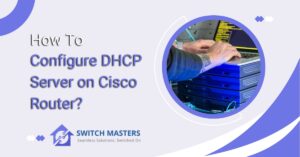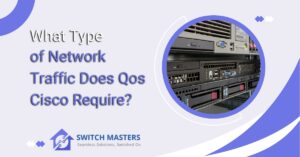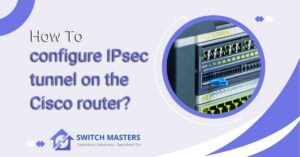Learn about How to Configure a Cisco Catalyst 2960 Switch. Learn step-by-step how to configure a Cisco Catalyst 2960 switch for optimal network performance.
Introduction
There is no doubt that the Cisco Catalyst 2960 Switch is a versatile networking device that is well known for its reliability and performance. The module plays a vital role in modern network infrastructures, providing seamless communication and data transfer across a variety of devices. Catalyst 2960 Switch offers advanced switching capabilities that facilitate efficient traffic management and prioritization. The product includes features such as Virtual LANs (VLANs), Quality of Service (QoS) controls, and Layer 3 routing.
These features enable administrators to tailor the network according to their needs. The Cisco Catalyst 2960 Switch has a robust hardware design and a variety of software capabilities that make it an essential component of enterprise networks, providing a solid basis for connectivity, security, and scalability.
Understanding the Cisco Catalyst 2960 Switch
We should familiarize ourselves with the Cisco Catalyst 2960 Switch before diving into the configuration process. A variety of features are available in this powerhouse device to enhance network performance, security, and scalability. Cisco Catalyst 2960 Switches have a range of robust hardware and advanced software features that make them a cornerstone of modern networking infrastructure.

How to Configure a Cisco Catalyst 2960 Switch?
Cisco Catalyst 2960 switches can be configured to give your network a customized look and feel. The process of organizing data flow is similar to setting up furniture in a room and ensuring that everything is connected properly. The following is a simple guide to get you started:
1. Access the Switch
The Ethernet cable should be used to connect your computer to the switch. A serial cable can be connected to the console port or the management port can be used. Your computer must be equipped with the necessary console or terminal emulator software.
2. Access Configuration Mode
Open the terminal emulator and establish a connection with the switch once you have connected. Upon pressing Enter a few times, a prompt should appear asking for your username. The username and password for the switch should be “Cisco” and “Cisco” respectively if this is your first time using the switch.
3. Enter Privileged EXEC Mode
Following your login, you will enter user EXEC mode, denoted by the “>” prompt. The “#” prompt indicates that you are entering privileged EXEC mode once you have typed “enable”.
4. Enter Global Configuration Mode
You can now type “configure terminal” or simply “conf t” and hit Enter to complete the configuration process. The command will take you to the global configuration mode, which allows you to configure various configuration options.
5. Set Hostname
Your switch can be named by entering the “hostname” command followed by the desired name. Using the example of “hostname MySwitch”, for example.
6. Configure Interfaces
Using the ‘interface [interface-id]’ command, you can configure each interface individually. Following this, you can set parameters such as the IP address, subnet mask, and membership in a VLAN by using commands such as the “IP address” and “switchport mode”.
7. Set VLANs
You can create VLANs by using the “vlan” command followed by the number of the VLAN. An example would be “VLAN 10”. A VLAN can be assigned to an interface via the “interface [interface-id]” command followed by the “switchport access vlan [vlan-id]” command.
8. Save Configuration
It is essential that you save your configuration once you have completed the configuration process. Then type “write memory” or “copy running-config startup-config” to save the configuration to non-volatile memory, and then type “end” to exit global configuration mode.
9. Verify Configuration
You can verify your configuration by typing “show running-config” to view the current configuration, or “show vlan” to view the VLAN configuration.
10. Exit Configuration Mode
Once the configuration mode has been exited, the privileged EXEC mode will be restored. The switch can then be logged out by typing “logout” or “exit”.
Feature of Cisco Catalyst 2960
Catalyst 2960 series routers feature some features that can be used to optimize network performance and simplify network management. The following are some of the key features:
- Gigabit Ethernet Ports: A feature of the Catalyst 2960 is its inclusion of Gigabit Ethernet ports, which provide high-speed connectivity for applications that require heavy data processing and multimedia streaming.
- Power over Ethernet (PoE): PoE is a feature of certain Catalyst 2960 models that allows both data and power transmission over Ethernet cables simultaneously. The use of this feature simplifies the deployment of IP phones, wireless access points, and other devices that can utilize Power over Ethernet.
- Quality of Service (QoS): The use of QoS features enables prioritization of network traffic based on application requirements, ensuring optimum performance for critical applications and services.
- Simple Network Management Protocol (SNMP): The Catalyst 2960 switches are compatible with the SNMP protocol that enables seamless integration with network management systems. This enables centralized monitoring, configuration, and troubleshooting.
- IPv6 Support: The Catalyst 2960 supports native IPv6 for compatibility with modern networking protocols, making the transition to IPv6-based networks as simple as possible.
- Energy-Efficient Design: Cisco’s EnergyWise technology minimizes power consumption by dynamically adjusting power levels according to device usage, thus reducing energy consumption and helping to maintain the environment.
- Stacking Capabilities: The Catalyst 2960 provides stacking capabilities. This enables the creation of a unified, high-performance switch stack for simplified management and greater scalability.
The Cisco Catalyst 2960 series is characterized by a variety of features that collectively contribute to its versatility, reliability, and performance, which makes it an ideal choice for organizations that require robust and reliable networking solutions.

FAQs
Can I configure port mirroring on the Cisco Catalyst 2960 Switch?
The port mirroring feature allows you to replicate traffic from one port to another for monitoring or analysis.
You can use the switch’s tracking features to effectively capture and inspect network traffic by configuring port mirroring.
What is the default username and password for accessing the switch?
When the switch is first set up, the default username is “Cisco”, and the default password is also “Cisco.” Once the switch is set up, you must change the default credentials, not only for security reasons but also so that the switch can be accessed.
Can I stack multiple Cisco Catalyst 2960 Switches for increased scalability?
Yes, the Cisco Catalyst 2960 Switch supports stacking capabilities, which allows you to expand your network infrastructure seamlessly.
The switches can be connected using StackWise cables and configured as a single logical unit using StackWise configuration software.
Conclusion
The ability to configure a Cisco Catalyst 2960 Switch is a critical skill for both network administrators and enthusiasts alike. Following the steps outlined in this guide and leveraging the switch’s powerful features will allow you to optimize your network infrastructure’s performance, security, and scalability.















